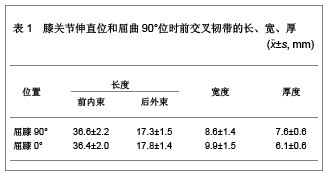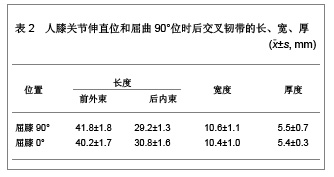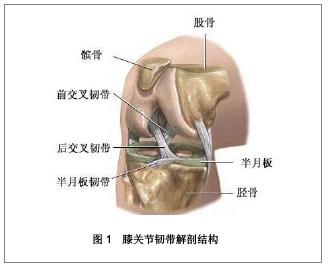| [1] 吴恩惠.中华影像医学(骨骼系统卷)[M].北京:人民卫生出版社,2002:241-243.[2] 马勇,敖英芳.双膝前交叉韧带损伤特点及治疗[J].中国运动医学杂志,2007,26(2):168-171.[3] Fanelli GC, Beck JD, Edson CJ. Combined PCL-ACL lateral and medial side injuries: treatment and results. Sports Med Arthrosc. 2011;19(2):120-130.[4] 陈志伟,刘春磊,杨乐忠,等.分期治疗外伤性膝关节脱位合并多韧带损伤的疗效观察[J].中国修复重建外科杂志,2011,25(2):225-228.[5] 韩增斌.LARS人工韧带与骨界面结合的研究[D].山东:泰山医学院,2009:1-46.[6] 刘秀梅,陶澄,肖东民.人膝关节前、后交叉韧带解剖研究及临床意义[J].医学临床研究,2006,23(7):1085-1087.[7] 陶澄,何爱咏,王万春.膝关节后交叉韧带解剖研究及临床意义[J].中国临床解剖学杂志,2007,25(2):176-178.[8] 就医网.膝关节内窥镜检查术[DB/OL].2007-10-25. http://server.91.cn/tuku/tsss/308175.htm[9] 李皓,王大平,陆伟,等.关节镜下前交叉韧带重建300例临床研究[J].中华临床医师杂志,2012,6(8):2020-2023.[10] Panni AS, Milano G, Tartarone M, et al. Arthroscopic treatment of malunited and nonunited avulsion fractures of the anterior tibial spine.Arthroscopy.1998;14(3):233-240.[11] Ross G, DeConciliis GP, Choi K, et al. Evaluation and treatment of acute posterolateral corner/anterior cruciate ligament injuries of the knee. J Bone Joint Surg Am. 2004;86(2):2-7.[12] Stäubli HU, Birrer S. The popliteus tendon and its fascicles at the popliteal hiatus: gross anatomy and functional arthroscopic evaluation with and without anterior cruciate ligament deficiency. Arthroscopy. 1990;6(3):209-220.[13] 尚静,杨玖玲,周嘉钰.前交叉韧带损伤MR的影像特征分析[J].中国现代医生,2012,50(14):89-90.[14] 刘湘阳,黄茂萍.后交叉韧带运动损伤的治疗[J].现代中西医结合杂志,2009,18(31):3855-3856.[15] 中国知网.中国学术期刊总库[DB/OL].2012-08-10. https://www.cnki.net[16] SCI数据库.Web of Sciencevia ISI Web of Knowledge[DB/OL]. 2012-08-10.http://ip-science.thomsonreuters.com/mjl[17] Arnoczky SP, Rubin RM, Marshall JL. Microvasculature of the cruciate ligaments and its response to injury. An experimental study in dogs. J Bone Joint Surg Am.1979;61(8):1221-1229.[18] 王守安,张胜昌,钟震亚,等.膝交叉韧带的血供及其临床意义[J].中国临床解剖学杂志,2009,27(5):516-519.[19] Dunlap J, McCarthy JA, Joyce ME, et al. Quantification of the perfusion of the anterior cruciate ligament and the effects of stress and injury to supporting structures. Am J Sports Med. 1989;17(6):808-810.[20] 程映华,顾永强,严勋.重建前交叉韧带血供的实验研究和临床应用[J].中华实验外科杂志, 2003,20(1):71-72.[21] Robinson D, Halperin N, Nevo Z. Devascularization of the anterior cruciate ligament by synovial stripping in rabbits. An experimental model. Acta Orthop Scand. 1992;63(5):502-506.[22] Clancy WG Jr, Narechania RG, Rosenberg TD, et al. Anterior and posterior cruciate ligament reconstruction in rhesus monkeys. J Bone Joint Surg Am. 1981;63(8):1270-1284.[23] Wickstrom KT, Spitzer RM, Olsson HE. Roentgen anatomy of the posterior horn of the lateral meniscus. Radiology. 1975;116(3):617-619.[24] 何正,张祚勇,赵晓东,等.人膝关节交叉韧带血供的显微解剖学研究[J].第三军医大学学报,2011,33(14):1514-1517.[25] 王守安,庄志强,张胜昌,等.髌韧带血供及其在重建膝交叉韧带中的意义[J].解剖与临床,2009,14(3):165-167.[26] Arnoczky SP. Blood supply to the anterior cruciate ligament and supporting structures. Orthop Clin North Am. 1985;16(1): 15-28.[27] 王澍寰.临床骨科学[M].上海:上海科学技术出版社,2005:1082-1086.[28] 杨志明.修复重建外科学[M].北京:人民卫生出版社,2001:721-724.[29] 孙康,王立德,张羽飞,等.人工合成材料重建膝关节交叉韧带的进展[J].骨与关节损伤杂志,2000,15(3):236-238.[30] 王永建.人工韧带在前交叉韧带重建中的作用[J].中国运动医学杂志,2002,21(3):301-303.[31] 何国础,钱不凡,杨庆铭,等.人发角蛋白人工腱在膝关节前交叉韧带损伤中的应用[J].骨与关节损伤杂志,2003,18(6):402-403.[32] Brunet P, Charrois O, Degeorges R, et al. Reconstruction of acute posterior cruciate ligament tears using a synthetic ligament. Rev Chir Orthop Reparatrice Appar Mot. 2005;91(1): 34-43.[33] Trieb K, Blahovec H, Brand G, et al. In vivo and in vitro cellular ingrowth into a new generation of artificial ligaments. Eur Surg Res. 2004;36(3):148-151.[34] 敖英芳.关节镜下重建膝交叉韧带的临床现状[J].中华骨科杂志,2001,21(10):588.[35] Murray AW, Macnicol MF. 10-16 year results of Leeds-Keio anterior cruciate ligament reconstruction. Keen .2004;11(1): 9-14.[36] 郭林,陈昊,何锐,等.LARS韧带重建前交叉韧带的近期疗效[J].中国修复重建外科杂志,2011,25(8):921-924.[37] Lavoie P, Fletcher J, Duval N. Patient satisfaction needs as related to knee stability and objective findings after ACL reconstruction using the LARS artificial ligament. Knee. 2000;7(3):157-163.[38] 吴宇黎,吴海山,李晓华,等.LARS人工韧带在前交叉韧带重建中的作用[J].实用骨科杂志,2007,13(1):4-6.[39] Nau T, Lavoie P, Duval N. A new generation of artificial ligaments in reconstruction of the anterior cruciate ligament. Two-year follow-up of a randomised trial. J Bone Joint Surg Br. 2002;84(3):356-360.[40] 范钦波,范继峰.关节镜下先进人工韧带加强系统和四股自体半腱肌腱重建前交叉韧带的疗效比较[J].中国修复重建外科杂志,2008,22(6):4-6.[41] Ishibashi Y, Tsuda E, Tazawa K, et al. Intraoperative evaluation of the anatomical double-bundle anterior cruciate ligament reconstruction with the OrthoPilot navigation system. Orthopedics. 2005;28(10):1277-1282.[42] Yagi M, Kuroda R, Nagamune K, et al. Double-bundle ACL reconstruction can improve rotational stability. Clin Orthop Relat Res. 2007;454:100-107.[43] Morgan CD, Stein DA, Leitman EH, et al. Anatomic tibial graft fixation using a retrograde bio-interference screw for endoscopic anterior cruciate ligament reconstruction. Arthroscopy. 2002;18(7):38.[44] Gorschewsky O, Stapf R, Geiser L, et al. Clinical comparison of fixation methods for patellar bone quadriceps tendon autografts in anterior cruciate ligament reconstruction: absorbable cross-pins versus absorbable screws. Am J Sports Med. 2007;35(12):2118-2125.[45] Lee MC, Jo H, Bae TS, et al. Analysis of initial fixation strength of press-fit fixation technique in anterior cruciate ligament reconstruction. A comparative study with titanium and bioabsorbable interference screw using porcine lower limb. Knee Surg Sports Traumatol Arthrosc. 2003;11(2):91-98.[46] 刘玉杰,李众利,王志刚,等.腘绳肌腱结嵌压固定法重建交叉韧带的临床应用与生物力学研究[J].中华外科杂志,2005,43(4): 239-242.[47] Petermann J, Gotzen L, Trus P. Reconstructive interventions of the posterior cruciate ligament--experimental studies of isometric aspects. Part II: Studies of the posterior cruciate ligament replacement model. Unfallchirurg. 1992;95(7):354-357.[48] Fleming B, Beynnon BD, Johnson RJ, et al. Isometric versus tension measurements. A comparison for the reconstruction of the anterior cruciate ligament. Am J Sports Med. 1993;21(1):82-88. |





